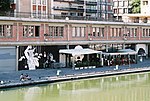Place du Colonel Fabien
10th arrondissement of Paris19th arrondissement of ParisFrance road stubsFrench Communist PartySquares in Paris
The Place du Colonel Fabien (in English: "Colonel Fabien Square") is a square in Paris, France Before the liberation of Paris, the square was called the Place du Combat and was renamed in honour of the French communist resistance hero, Pierre Georges, whose nom-de-guerre was Colonel Fabien. The headquarters of the French Communist Party, designed by the Brazilian communist and utilitarian architect Oscar Niemeyer is located here, as is a station of the Paris Métro. Nearby is the former location of the medieval Gibbet of Montfaucon, a multi-tiered gibbet that was for most of its history outside Paris' city walls.
Excerpt from the Wikipedia article Place du Colonel Fabien (License: CC BY-SA 3.0, Authors).Place du Colonel Fabien
Place du Colonel Fabien, Paris Quartier de la Villette (Paris)
Geographical coordinates (GPS) Address External links Nearby Places Show on map
Geographical coordinates (GPS)
| Latitude | Longitude |
|---|---|
| N 48.878055555556 ° | E 2.3702777777778 ° |
Address
Place du Colonel Fabien
Place du Colonel Fabien
75019 Paris, Quartier de la Villette (Paris)
Ile-de-France, France
Open on Google Maps










